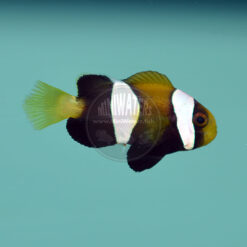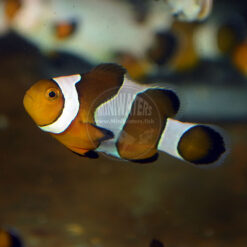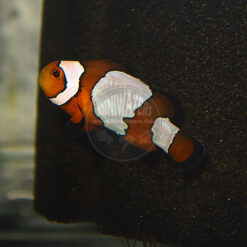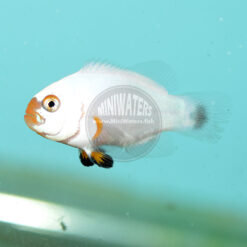Amphiprion ocellaris “Fancy White Smudgy” Ocellaris Clownfish
$99.00
SMUDGY Ocellaris Clownfish. Definitely something you’re not going to see just anywhere.
No one really knows what it is, but these days we all know what it looks like. Cloudy, hazy patches of bar coloration over the flanks, generally areas that have lost the normal “black” margin and crisp border demarcation see in the bars of clownfish.
All the Smudgy I will offer at this time are sold to me as “Fancy White Smudgy”, so that is how I will retail them. It is likely that the individual genetics of a Smudgy Ocellaris will only be proven once it is bred; if no Davinci-type offspring show up, then the fish doesn’t carry the gene.
About Our Standard Offerings of Smudgy Ocellaris Clownfish
Most Smudgy Ocellaris I’ve seen only show a smudge on one side of their body. Generally, the other side of the body has wild-type, normally 3 stripe patterning. If you are not content with sight-unseen fish, you may be better off checking for a WYSIWYG offering.
Read More about the Smudgy Ocellaris Clownfish, and the Fancy White Clownfish that they arise from, below:
Description
SMUDGY Ocellaris Clownfish. Definitely something you’re not going to see just anywhere.
No one really knows what it is, but these days we all know what it looks like. Cloudy, hazy patches of bar coloration over the flanks, generally areas that have lost the normal “black” margin and crisp border demarcation see in the bars of clownfish. Sustainable Aquatics is one of the only places where I’ve seen the occasional “smudgy” Ocellaris clownfish produced and made available. Their Smudgy or Smudge Clownfish appear in Fancy White breeding; whether all of these fish carry the “DaVinci” gene responsible for the look of a typical Fancy White is unclear. Interestingly, we do not see “Smudgy” variants showing up in our own local Fancy White breeding; this is truly something rare and unusual.
What the “Smudgy” genetic is, is also unclear. Single gene? Multi-gene? Can it be reproduced?
All the Smudgy I will offer at this time are sold to me as “Fancy White Smudgy”, so that is how I will retail them. It is likely that the individual genetics of a Smudgy Ocellaris will only be proven once it is bred; if no Davinci-type offspring show up, then the fish doesn’t carry the gene.
Regardless of the DaVinci gene content, any fish sold as Smudgy will obviously show this cloudy, hazy barring pattern. Smudgy potentially represents something new genetically in clownfish (we see similar markings in some Picasso Percula and of course, the Nebula which is at least in part defined by the presence of smudgy markings). Working with Smudgy Ocellaris will be an exiting and interesting challenge for the breeders to undertake. Who will crack the code? What new multi-gene combinations could be created? It’s impossible to say at this time.
About Our Standard Offerings of Smudgy Ocellaris Clownfish
Most Smudgy Ocellaris I’ve seen only show a smudge on one side of their body. Generally, the other side of the body has wild-type, normally 3 stripe patterning. If you are not content with sight-unseen fish, you may be better off checking for a WYSIWYG offering.
I’ve included more information on the Fancy White background, that may or may not be present in this fish, below.
About Fancy Whites
The Fancy White is a designer variant of the Ocellaris Clownfish, Amphiprion ocellaris. It originated in the tanks of Bill Addison’s C-Quest hatchery several years back now. But there’s an interesting genetic story at play here. Despite having unusual bar patterns, in every other respect, the Wyoming White is simply a standard A. ocellaris. It just has one copies of a mutant gene that affect how stripes develop on the flanks of the fish. The related Wyoming White Clownfish has two copies of this same mutant gene. Fancy Whites are carriers of the DaVinci gene; we’d shorthand it as Dv/+ as breeders.
In any case, mating two “Fancy Whites” together will yield rather predictable outcomes; 25% wild-type fish, 50% Fancy Whites, and 25% Wyoming Whites. By the same token, because Wyoming Whites are Dv/Dv, the hypothesis is that they must pass along a Dv gene to every one of their offspring.
Fancy Whites, Gladiators and Davinci’s are more or less names for the same thing. Fancy White, originating out of Sustainable Aquatics, are considered to simply be carries of the Davinci gene that are also members of the “Fancy” Ocellaris strain (Fancy being SA’s line-bred ocellaris which have thicker black margins and the possibility of showing black on the flanks later in life). Later in life they can turn quite dark on the flanks, sometimes appearing more like “Mocha” hybrids than pure A. ocellaris.
Additional information
| Scientific Name | Amphiprion ocellaris |
|---|---|
| Captive-Bred | |
| Breeder | Sustainable Aquatics |
| Sizes Available | Small |
| FishBase Link | http://fishbase.org/summary/Amphiprion-ocellaris.html |
| Wholesale Available | No |
Related products
Clownfish


















































